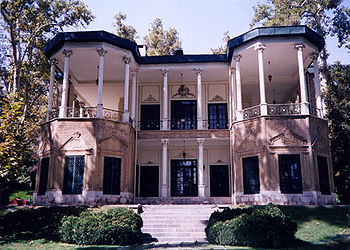
Niavaran Palace Complex
Encyclopedia

Tehran
Tehran , sometimes spelled Teheran, is the capital of Iran and Tehran Province. With an estimated population of 8,429,807; it is also Iran's largest urban area and city, one of the largest cities in Western Asia, and is the world's 19th largest city.In the 20th century, Tehran was subject to...
, Iran
Iran
Iran , officially the Islamic Republic of Iran , is a country in Southern and Western Asia. The name "Iran" has been in use natively since the Sassanian era and came into use internationally in 1935, before which the country was known to the Western world as Persia...
. It consists of several buildings and a museum. The Sahebqraniyeh Palace, from the time of Naser al-Din Shah of Qajar dynasty
Qajar dynasty
The Qajar dynasty was an Iranian royal family of Turkic descent who ruled Persia from 1785 to 1925....
, is also inside this complex. The main Niavaran Palace, completed in 1968, was the primary residence of the last Shah, Mohammad Reza Pahlavi
Mohammad Reza Pahlavi
Mohammad Rezā Shāh Pahlavi, Shah of Iran, Shah of Persia , ruled Iran from 16 September 1941 until his overthrow by the Iranian Revolution on 11 February 1979...
and the Imperial family until the Iranian Revolution
Iranian Revolution
The Iranian Revolution refers to events involving the overthrow of Iran's monarchy under Shah Mohammad Reza Pahlavi and its replacement with an Islamic republic under Ayatollah Ruhollah Khomeini, the leader of the...
. The main palace was designed by the Iranian architect Mohsen Foroughi.
History
The Niavarān Palace Complex traces its origin to a garden in NiavaranNiavaran
Niavaran is a district in the north of Tehran foothills. Bordering leafy, uphill-winding Darband Street, it can be reached from Tajrish Square, and is close to Darabad at the far north-eastern corner of Greater Tehran....
, Tehran, that was used by Nasir al-Din Shah as a summer residence. The palace erected by Nasir al-Din Shah in this garden was originally referred to asThe Niavarān Palace and was later renamed The Sahebqraniyeh Palace. During the reign of Mohammad Reza Pahlavi all the peripheral buildings of The Sahebqraniyeh Palace, with the exception of The Ahmad-Shahi Pavilion (or Kushk-e Ahmad-Shahi), were demolished and the buildings and the structures of the present-day Niavarān Palace Complex were built to the north of The Sahebqraniyeh Palace. In this period, The Ahmad-Shahi Pavilion served as an exhibition area of the presents of the world leaders to Iran.
See also
- TehranTehranTehran , sometimes spelled Teheran, is the capital of Iran and Tehran Province. With an estimated population of 8,429,807; it is also Iran's largest urban area and city, one of the largest cities in Western Asia, and is the world's 19th largest city.In the 20th century, Tehran was subject to...
- Iran Cultural Heritage Organization
- Private library of the Niavaran PalacePrivate library of the Niavaran PalaceThe private library of the Niavaran Palace or Farah Diba private library is located in the eastern part of the Niavaran Palace Complex, in two floors and one basement in a 770 square meter area and it was built in 1976...
- Architecture of Iran
- Golestan PalaceGolestan PalaceGolestān Palace pronounced "Kakheh Golestān" is the former royal Qajar complex in Iran's capital city.The oldest of the historic monuments in Tehran, the Golestan Palace belongs to a group of royal buildings that were once enclosed within the mud-thatched walls of Tehran’s Historic Arg...
- Sadabad PalaceSadabad PalaceThe Saadabad Palace is a palace built by the Pahlavi dynasty of Iran in the Shemiran area of Tehran.The complex was first inhabited by Qajar monarchs and royal family in the 19th century. After an expansion of the compounds, Reza Shah lived there in the 1920s...
External links
- Niavaran Palace Website
- A short video of the Niavaran Palace Complex, YouTube, http://www.youtube.com/watch?v=oTRnmVODnjo (9 min).

